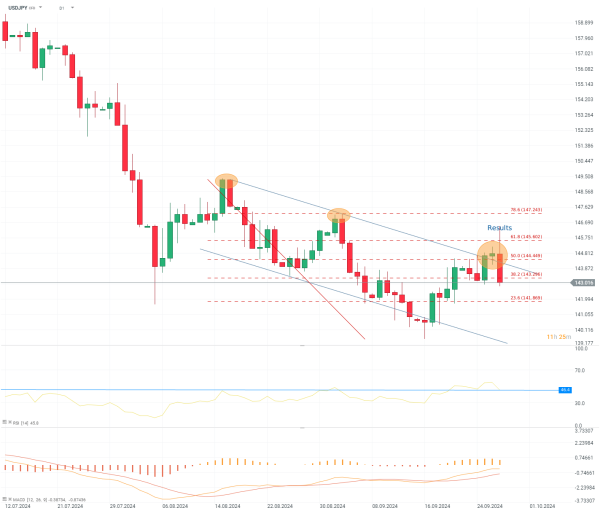Chart of the day - USDJPY (27.09.2024)
The USDJPY pair has experienced significant volatility today following major political developments in Japan and the release of new economic data. Former defense minister Shigeru Ishiba has won the Liberal Democratic Party's (LDP) leadership contest, setting him up to become Japan's new prime minister. This political shift, combined with recent inflation figures, has created a complex and dynamic environment for the currency pair.
Ishiba's victory came after a closely watched race that ended in a runoff vote against economic security minister Sanae Takaichi. The 67-year-old Ishiba, known for his willingness to criticize his own party and his focus on rural revitalization, now faces the challenge of improving the LDP's image ahead of next year's general elections. His victory has been met with mixed market reactions, reflecting uncertainty about the potential policy shifts under his leadership.
The currency markets responded dramatically to these events. Initially, when it appeared that Takaichi might win, the USDJPY pair spiked above 146.00. However, as news of Ishiba's ultimate victory spread, the pair saw a sharp reversal, tumbling to around 143.80. This volatility underscores the market's sensitivity to potential changes in Japan's economic and monetary policies. Adding to the complex picture, Tokyo's latest Consumer Price Index (CPI) data showed a decrease in inflation. The CPI increased by 2.2% year-over-year in September, down from a 2.6% rise in August. This declining trend in inflation could influence the Bank of Japan's (BOJ) monetary policy decisions, which are already under scrutiny given the change in political leadership.
Ishiba's economic agenda, which includes promises of a "full exit" from Japan's high inflation rates and achieving "growth in real wages," will be closely watched by market participants. His stance on monetary policy and any potential pressure on the BOJ to adjust its ultra-loose policy could have significant implications for the Yen's value. The new prime minister-to-be also faces broader economic and geopolitical challenges. Japan's economy has been grappling with rising living costs, exacerbated by a weak Yen. Additionally, Ishiba will need to navigate Japan's crucial relationship with the United States amidst growing security challenges in Asia, including tensions with China and North Korea. For traders and investors, the key factors to watch in the coming weeks will be any signals from Ishiba about his economic priorities, potential changes in BOJ leadership or policy, and how these factors might influence inflation trends and wage growth in Japan. The USDJPY pair is likely to remain sensitive to these developments, as well as to any shifts in U.S. Federal Reserve policy expectations.
USDJPY (D1 interval)
USD/JPY broke through key resistance only to fall back into the downtrend channel. This level has acted as strong resistance twice before, leading to a continuation of the downtrend. Since the beginning of August, lower highs and lower lows have been observed. The resistance also aligns with the 50% Fibonacci retracement level, which served as strong resistance at the end of August. USD/JPY has now broken through the 38.2% Fibonacci retracement, which might pave the way for an easy move to the 23.6% Fibonacci retracement level at 141.869.
The RSI is trending upwards and showing bullish divergence, which could be broken soon indicating a change of trend. MACD is making higher highs and higher lows, with a recent crossover indicating a buy signal.
